Outdoor Activities and Adventures, Budapest
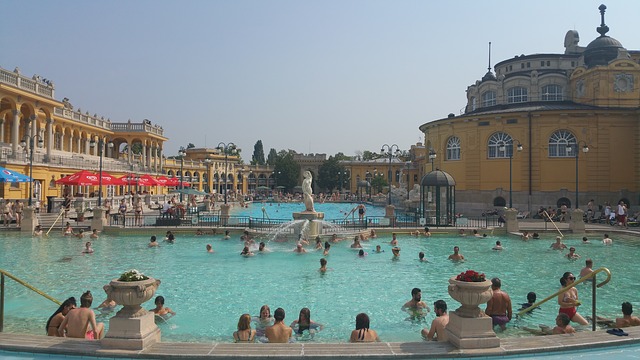
Removed from Unnamed collection
Szechenyi Thermal Bath 
With 21 pools, Széchenyi Bath is one of the largest bathing complexes in Europe. Its adventure pool features a water chute, underwater jacuzzi, neck shower and bubble deck. In addition to traditional medicinal services, the entrance fee also includes wellness services such as the fitness gym, saunas and underwater gymnastics. https://www.budapestinfo.hu/szechenyi-thermal-bath-and-swimming-pool-1
Map

Removed from Unnamed collection
Margaret Island 
Walking the length of the island takes about 20 minutes, but most visitors spend time at the Hajós Alfréd and the Palatinus outdoor pools. The Palatinus water park is a popular place in the summer, especially on the weekends. The 11 outdoor pools, including two for children, are in a beautiful setting. If it is too cold to go for a swim, an island tour introduces relics hailing back to the island's religious origins, including a 12th century convent and ruins of a Franciscan and a Dominican church. During summer months, bicycles, inline skates and 'bringóhintó', a four-wheeled bike for four, are available for rent. Since vehicles are prohibited, the island is a fantastic escape from the bustle of the big city and a great place to work out, swim a few laps, or go for a run.
Other attractions on the island include the Centennial Memorial which commemorates the 100th anniversary of Budapest, a Japanese Garden, a tiny zoo, a music fountain, and an octagonal water tower, built in Art Nouveau style in 1911. The outdoor theater hosts operas, concerts and plays during summer.
The thermal water on Margaret Island is famous for its healing effects. The natural, thermal water running beneath the island was first brought to the surface in 1886. In addition to its healing power, a day at the Danubius Health Spa is also a great way to relax and unwind. http://visitbudapest.travel/guide/budapest-attractions/margaret-island/
Map
Explore more places related to this search:
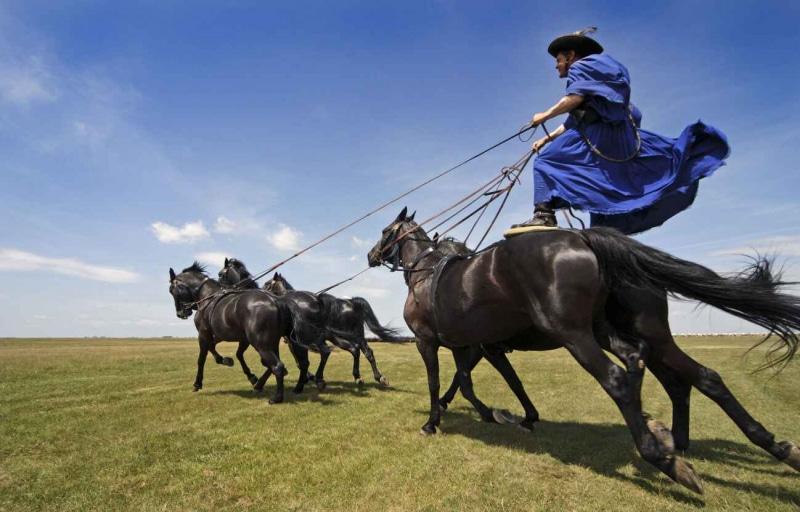
Removed from Unnamed collection
Hortobagy 
Proudly bearing its title of UNESCO World Heritage Site, Hortobágy National Park is the perfect archetype of pristine natural landscapes. This is the place where everyone longs to find refuge from the monotony of modern human existence. The feeling of unfettered freedom, encapsulated in the spectacle of the endless horizon, mirages, grazing herds of cattle and horses, and sweep-pole wells, will capture your imagination and soul during a horse-and-carriage ride or “puszta” safari.
A picturesque trip to the fishponds on the small narrow-gauge train, combined with some birdwatching, will serve unique experiences to both young and older adventurers. Here the breeze wafts the scent of fragrant chamomile, mint, and artemisia from wild fields, gently touching your nose just like the waves of the ocean rhythmically splashing on the shore. It is a place where you will reinterpret the meaning of silence.
It is a place where you might even reach celestial bodies during the special night treks in Starry Sky Park. In Hungary’s oldest and largest national park, awarded the European Destinations of Excellence (EDEN) prize, hundred-year-old herdsman’s traditions are still part of people’s means of subsistence and not mere promotional gimmicks. https://visitdebrecen.com/see-do/hortobagy/
Map
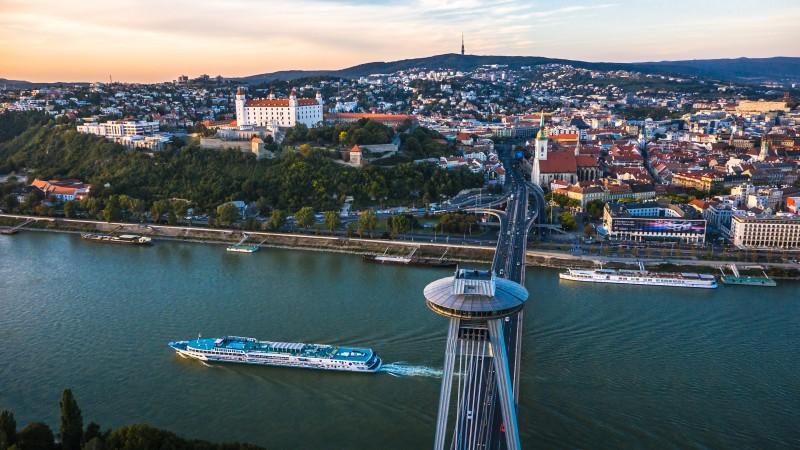
Removed from Unnamed collection
UFO 
A unique observation tower, a bar and a restaurant are located at the very top of the SNP bridge pylon.
“Floating” on the pillar of the New Bridge (Nový most), this restaurant offers a pretty unconventional experience, from where you can enjoy a unique panoramic view of Bratislava and its surroundings from above. The restaurant interior is elegantly furnished and the menu contains a wide variety of different international dishes. The restaurant has a total of 140 seats and reservations are possible. Offering an impressive view, this restaurant is a landmark of Bratislava and represents Slovakia in the World Federation of Great Towers. https://www.visitbratislava.com/places/ufo/
Map

Removed from Unnamed collection
Bratislava Castle 
The former seat of the rulers, today the symbol of Bratislava and the seat of the Museum of History. There is a wonderful view of the city and the neighbouring countries from its 47-metre-high crown tower in which royal coronation jewels used to be deposited. https://www.visitbratislava.com/places/bratislava-castle/
Map
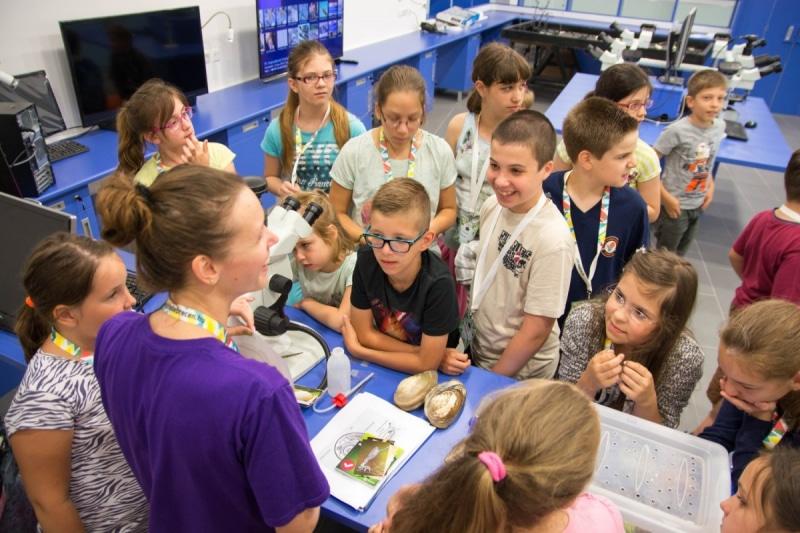
Removed from Unnamed collection
Agora Science Adventure Center 
Agora presents serious scientific knowledge and the little wonders of everyday life in a fun and easy-to-understand way.
The center is a new attraction in the life of the region; it offers exciting adventures and lifelong experience to all age-groups. It presents serious scientific knowledge and the little wonders of everyday life in a fun and easy-to-understand way. Agora features more than thirty interactive games and gets visitors involved in spectacular experiments. At the top of the futuristic three-storey building, stargazers will be delighted to test the limits of the observatory taking aim at the Sun, our fellow planets and other celestial bodies. https://www.debrecen.hu/en/tourist/places/agora-scientific-adventure-center
Map
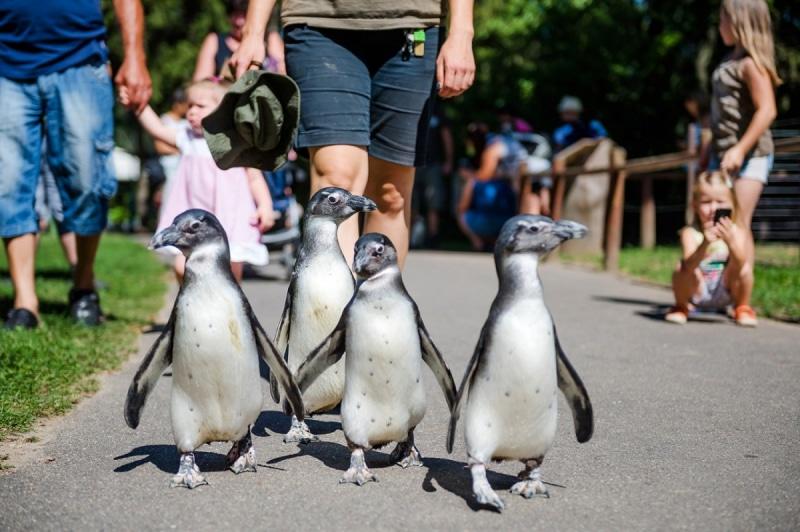
Removed from Unnamed collection
Debrecen Zoo and Amusement Park 
Open all year round, the Debrecen Zoo is home to some 900 individuals of 170 species from all five continents. Besides permanent exhibits, there are a number of daily events and activities involving close visitor encounters with fascinating animals as part of the Animals in Action program, as well as a number of seasonal events such as summertime Evening Walks or Animal Christmas. A full member of the European Association of Zoos and Aquaria (EAZA) since 1994, the Zoo also reflects the current need for the protection of biodiversity by contributing to coordinated conservation efforts like European Endangered Species Programs (EEPs) through managing healthy and productive populations of various endangered species like the leopard cat, the reticulated giraffe, the African penguin, and the ring-tailed lemur.
Integrated into the Zoo and Amusement Park, the ever-growing botanical collection currently features around 650 species, including ones from the Great Forest biotope and other parts of Hungary as well as ones native to various exotic corners of the world. There is also a Scent Garden section, home to a wide variety of aromatic herbs, enabling visitor interaction through the sense of smell. https://www.debrecen.hu/en/tourist/places/nagyerdei-entertainment-complex
Map
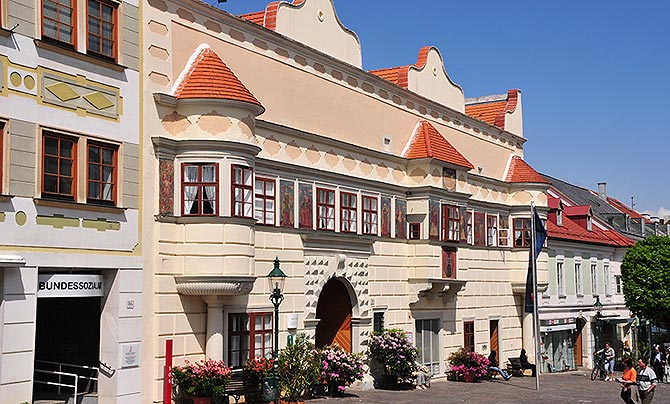
Removed from Unnamed collection
Eisenstadt City Hall 
The structural fabric of the town hall dates back to 1560 and was changed after the city had been elevated to a royal free-trade zone in 1648.
The architectural basis is thought to go back to early renaissance. The diamond-shaped ashlar of the portal points to this era, too.
The one-storey building with a broad front featuring two round oriels on the sides and a rectangular oriel in the centre has been refurbished during the baroque; a massive attic has been built on top of it during the same period. The murals discovered in 1926 probably also go back to the early renaissance period and have been adapted to fit the baroque tastes later on. In 1949 Rudolf Holzinger repainted them by closely sticking to old patterns. He also completed the missing pictures. https://eisenstadt-leithaland.at/city-hall.html
Map
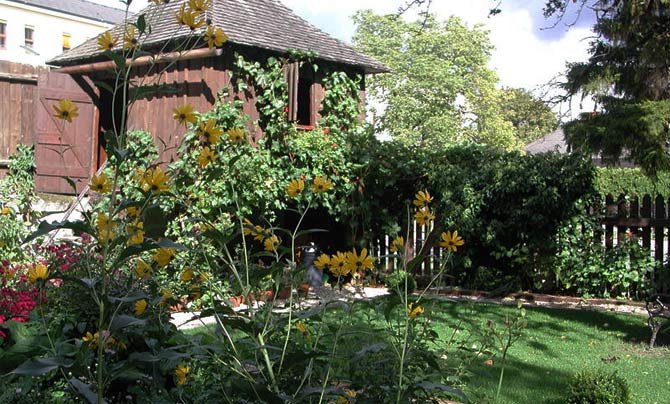
Removed from Unnamed collection
Haydn's Herb Garden 
The Haydn's family garden hut with its herb gardens represents a true rarity.
When Joseph Haydn bought his house in the city in 1766, he also acquired the little garden by the hospital, situated outside the city walls, and the little wooden hut.
Haydn transformed this small piece of land in a flower and herb garden and not only came there to seek peace and quiet, but also to compose.
The remains of the kitchen and herb garden have been transformed into a show garden with plants that were en vogue in Haydn's times. It invites the visitors to learn more about century old recipes and herbal secrets. https://www.eisenstadt-leithaland.at/en/sightseeing/sightseeing/haydns-herb-garden
Map

Removed from Unnamed collection
Palace Park 
The Palace Park, with the Leopoldine Temple and the Orangery at the heart of it, is a jewel.
The Palace Park is one of the most important landscaped gardens dating back to the 19th century. It covers an area of about 50 hectares and forms the northern edge of the city and goes all the way down to Bergstrasse and up into the Leitha Mountains.
The park comprises four ponds (Leopoldine pond, Obelisk pond, Herzerl pond and Engine pond), uncounted exotic trees and bushes.
The Leopoldine Temple built by Moreau in 1806 is a circular temple with Egyptian-style columns erected right above the Leopoldine pond. Inside the temple there is the statue of "Leopoldine", made in 1805 by the famous Italian sculptor Antonio Canova. https://eisenstadt-leithaland.at/palace-park.html
Map
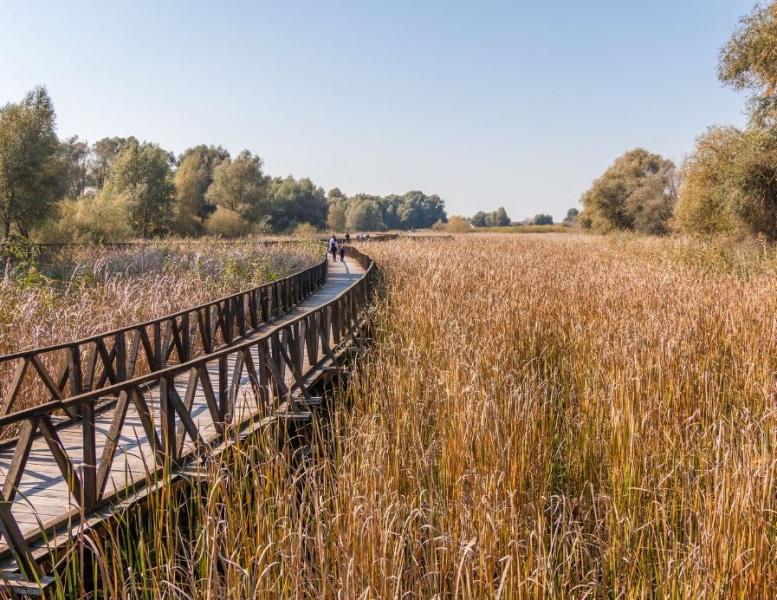
Removed from Unnamed collection
Kopacki Rit Nature Park 
Kopacki Rit (pronounced ko-pachkee rit) Nature Park is a flood area ( rit means marsh) between the Drava and Danube rivers in the Osijek-Baranjska region of eastern Croatia. Sometimes called "the pearl of the Drava", the nature park covers 177 sq kilometres holding more than 20000 waterbirds in winter of 267 different species. You'll find cormorants, herons, gulls, terns, ducks and egrets Some of the birds such as the black stork and the great white egret are rare in Europe but the most prized inhabitant of Kopacki rit is the largest Croatian eagle, the white-tailed eagle.
As the largest remaining wetlands in Europe, Kopacki rit changes in accordance with the seasons. In spring, high waters, mostly from the Danube, flow in the marshlands bringing fish that come to spawn in the shallows The warmth makes the water plants, plankton and insects flourish making it one of the most fertile spawning areas of the Danube region Spring is also marked by an explosion of frogs.
In the central part of the reserve is a lake that is connected to the Danube by a canal that serves as a conduit for most of the water throughout the marshlands The north part of the park is composed of willow, poplar, oar and ash forests. Here you'll find deer, wild boar, fox wildcats, martens, weasels and other creatures. https://www.croatiatraveller.com/National%20Parks/Kopacki.htm
Map
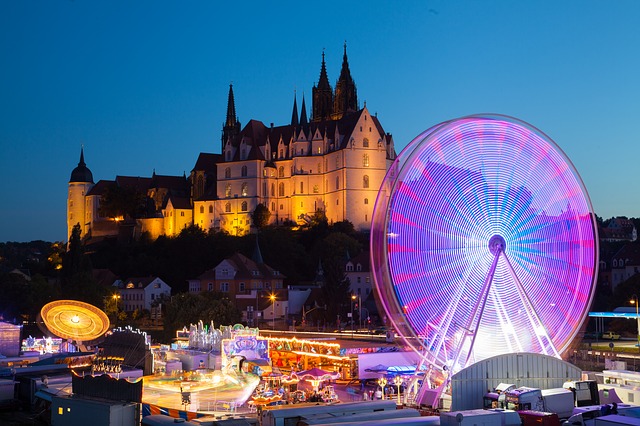
Removed from Unnamed collection
Prater 
An amusement park for many, place of nostalgic dreams for some, oasis of greenery for almost everyone – and the location of the Giant Ferris Wheel, one of Vienna’s most famous symbols. The Vienna Prater is in season from March to October. But the world-famous Giant Ferris Wheel and a few other attractions are open all year round.
The Vienna Prater is entertaining and exciting, but it can also be relaxing and quiet. One part of it contains attractions ranging from a nostalgic merry-go-round to an ultra-modern roller coaster. In the other area, known as the “Green Prater,” one finds widespread meadows to lie on, shady trees, and quiet paths. The motto is to have fun and enjoy yourself.
Today, the Green Prater is a paradise for walkers, runners, bicyclists and horseback riders, and is highly appreciated as a large leisure area within the city limits. To get an overview of this green oasis in the city of Vienna, one best takes the Liliputbahn, a miniature railway spanning more than three miles. https://www.wien.info/en/sightseeing/prater
Map

Removed from Unnamed collection
Schoenbrunn Zoo 
Schönbrunn Zoo in Vienna is the world’s oldest zoo still in existence and has already been voted Europe’s best zoo on five occasions. Today the Zoo at Schönbrunn is considered one of the best and most modern zoos in the world. Each year more than two million visitors come to see the panda baby, newborn elephants and many other rare animals. More than 700 kinds of animal live here - from the Siberian tiger to koalas and rhinoceros. Highlights are the giant rainforest house, the large South American enclosure and the ORANG.erie, home to Vienna's orangutans.
New and extensive enclosures and animal houses are added each year. But the zoo's historic charm is always preserved. The zoo is part of the Schönbrunn UNESCO world heritage site. In the summer of 1752, Emperor Franz I. Stephan von Lothringen, Maria Theresia's husband, took his royal guests to the newly constructed menagerie in the park at Schönbrunn Palace for the first time. Ever since then, the world's oldest zoo has been operating in Vienna. https://www.wien.info/en/sightseeing/sights/imperial/schoenbrunn-zoo
Map
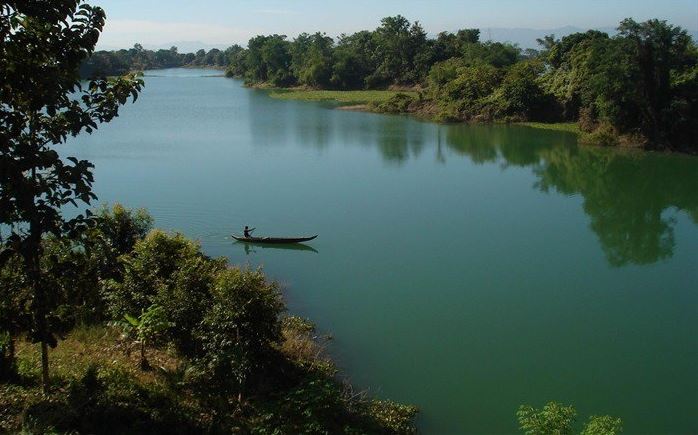
Removed from Unnamed collection
Lunca Muresului Natural Park 
The Lunca Muresului Natural Park (Floodplain) is a protected area in Romania, downstream of Arad, until to the border with Hungary, along the river Mures, classified as a natural park at the national level and as a terrestrial landscape protected by IUCN (International Union for Conservation of Nature).
It comprises the dammed area of the river Mures, respectively the flood area of dams on either side of the river between high terraces of the same river. Is an area with periodic flooding where the surrounding plants and animals are adapted to this regime.
Lunca Muresului Natural Park Natural Park hosts over 200 species of birds. In the forests of the park, we will find deer, wild boar, squirrel and fallow deer. http://www.uvisitromania.com/tourist-attractions/arad/lunca-muresului-natural-park-id550
Map

Removed from Unnamed collection
The Garden Tulln 
From April to October, Garden Tulln is the main attraction in town for gardening enthusiasts. Garden Tulln opened as a garden show for the province in 2008 and continues to be a showcase project in Europe today with its 70 ecologically maintained extravagant model gardens!
Garden Tulln provides ideas for amateur gardeners, an excursion destination for nature lovers and an adventure land for families. It is a green paradise ideal for strolling and marvelling, playing and entertaining, relaxing and rejuvenating!
Besides the diversity of its individual model gardens, this garden show also has the following attractions in store for all generations:
Treetop trail: View of model gardens and the Danube landscape from 30 meters in the air;
Tips and tricks: Help and advice from gardening pros and nature-in-the-garden experts;
Nature playground: Playing and exploring on the biggest natural adventure playground in Lower Austria. http://erleben.tulln.at/en/garden/garden-city-tulln/garten-tulln/
Map

Removed from Unnamed collection
Zebracka 
Žebračka is an example of a floodplain forest, which has been preserved to the present as a type of hard meadow in the Bečva river basin. It has a size of 235ha and is located on the outskirts of Přerov. In this locality, the most typical wood species are oak, lettuce, hornbeam and ash. The northern part flows through the artificial canal Strhanec, which during its existence has gained a nature close to nature. http://www.pavoj.wz.cz/priroda/zebracka/zebracka.html
Map

Removed from Unnamed collection
Luzanky Park 
Lužánky Park was established in 1786 as one of the first public parks in Central Europe. In the middle of the park, you can visit the Renaissance Revival pavilion from 1855 by Viennese architect Ludwig Förster, which has held balls, concerts, celebrations, and various expositions over the years. Today, the building goes by the name Kasino and serves mainly as a leisure-time centre for children.
The park as we know it was created in 1840 by city gardener Antonín Šebánek. In addition to the park’s precious trees, visitors may enjoy watching colourful fish in the stream and cute piglets – a favourite attraction for the park’s youngest visitors. There’s also a playground for children to enjoy and get some energy out.
Lužánky is an ideal place for sporting as well as social activities, as locals come here to jog, play tennis, pétanque, and volleyball, exercise in an outdoor gym, or get a bite to eat at one of a number of nearby restaurants. Visitors can also use a public grill for barbecuing. https://www.gotobrno.cz/en/place/park-luzanky/
Map

Removed from Unnamed collection
Moravsky Kras 
The largest and most beautiful karst area in central Europe is a place where visitors have their breath taken clean away. The main attraction here is the famous Macocha Abyss, some 138m deep and steeped in terrifying myths and legends. Without doubt the Moravian Karst is one of the natural wonders of the Czech Republic, which will wow every visitor. http://www.czechtourism.com/c/moravian-karst/
Map
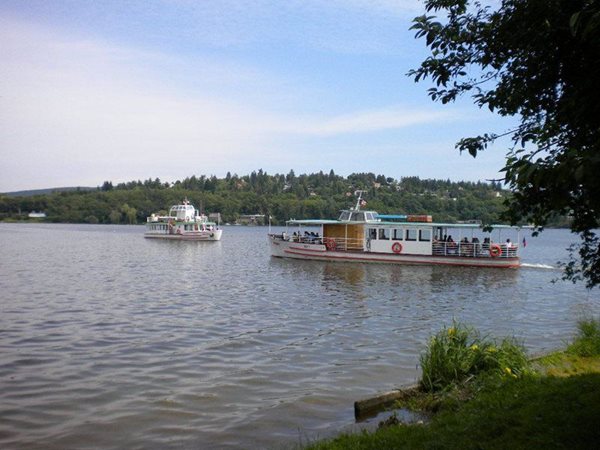
Removed from Unnamed collection
Brno Reservoir 
A popular recreational resort and an ideal place for all kinds of water sports. The banks are lined with sport facilities, restaurants, pubs and kiosks. The regular water transport line serving the route Brno - Veverská Bítýška is in operation every year from April to September. The visitors coming from the city centre can get to the reservoir by public transport. http://www.czechtourism.com/c/brno-reservoir/
Map
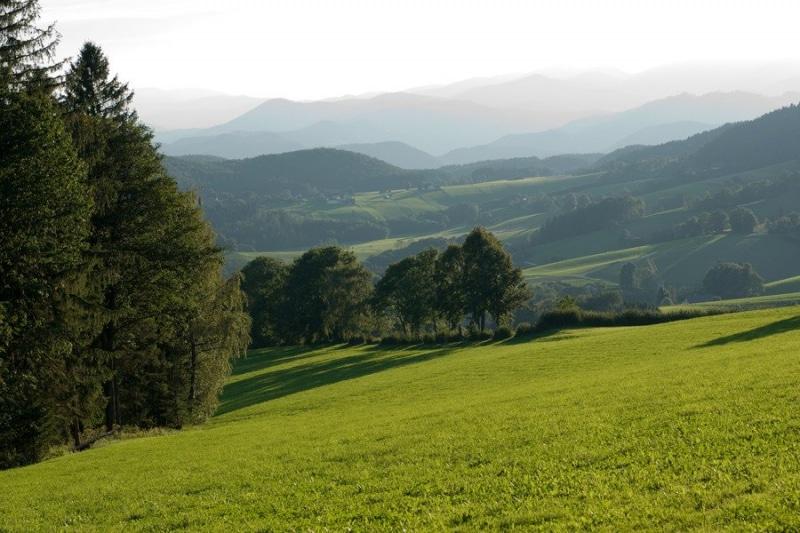
Removed from Unnamed collection
Schoeckl Mountain 
At 1445 metres not exactly the highest, but the Schöckl, local mountain of Graz, is an extremely popular destination. Featuring everything from steep slopes to an extended plateau, it holds an almost supernatural fascination for visitors. Many hike around it several times per week, ascend on their mountain bikes or treat themselves to the comfortable cable car from St. Radegund, all with a view to rising above workaday concerns for a real highlight.
In terms of its geology, the Schöckl is a limestone mountain with a core of crystalline rock. At the interface of permeable and impermeable rock, springs come to the surface. Thanks to radioactive springs and healthy air, the village of St. Radegund on the southern foot of Schöckl became an internationally renowned spa in the 19th century. https://www.graztourismus.at/en/see-and-do/sightseeing/trips-around-graz/schockl-mountain_af-1271
Map
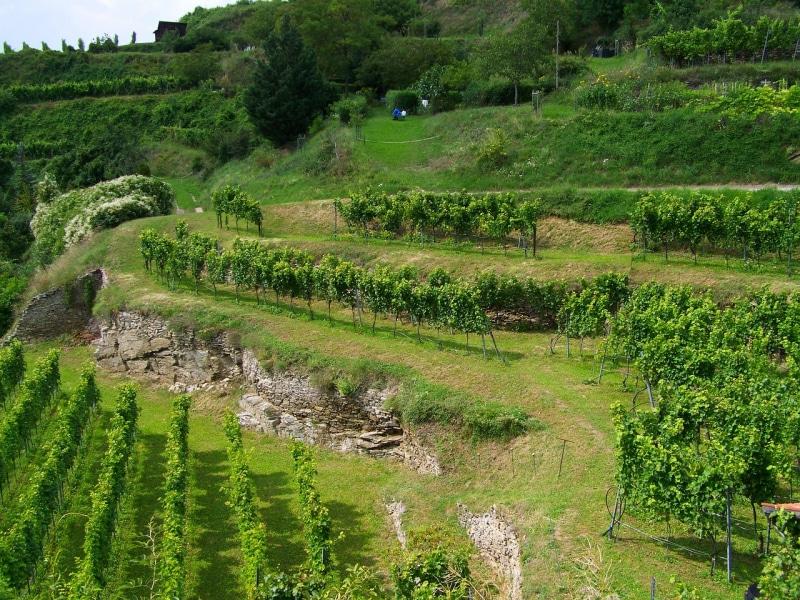
Removed from Unnamed collection
Winzer Krems 
Krems is a famous wine region and produced one of the finest bottles since 1983.
Winzer Krems, Sandgrube 13, is one of the best-known wine addresses in Austria. Its setting is unique: at the gateway to the World Heritage cultural landscape of the Wachau, one of the most beautiful stretches of river valley in Europe. Pleasurable in the truest sense of the world.
he centre of this region is the small picturesque town of Krems, situated in the Danube valley, marking the eastern border of one of Europe's most beautiful river landscapes - the Wachau.
Most of the vineyards in Krems are placed on sun exposed primary rock and loess terraces with difficult access. The basis for the quality wines from Krems is provided by the special soil an climate conditions. The influence of the river Danube produces a mix of warm air from the South-East and cool spicy air from the North. From this micro-climate and from the soil of wLoessW or the prehistoric rock the vines create that distinctive aroma full of fruit which distinguishes wines from WINZER KREMS. https://www.winzerkrems.at/en/
Map
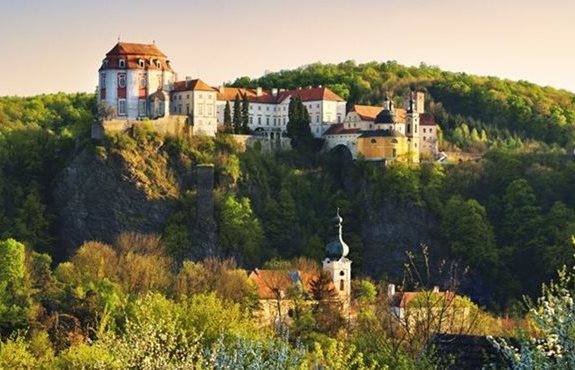
Removed from Unnamed collection
Podyji National Park 
Even though it is the smallest Czech national park, the Podyjí National Park is among the most important natural sites in Central Europe. Here you will find an exceptionally well-preserved river valley in a richly wooded landscape full of breathtaking scenery. http://www.czechtourism.com/c/podyji-national-park/
Map

Removed from Unnamed collection
Wachau Cruise 
Between late March and early November, the proud red and white DDSG fleet departs for relaxed cruises through the Wachau region, a UNESCO World Cultural Heritage, up to 3 times per day in each direction. A cruise in the Wachau region is always a special experience – no matter if in spring when the apricot and other trees are in full bloom, in summer when you can enjoy bright blue skies, or in autumn when you can watch the afternoon sun bathing the vineyards in red and gold. Our dense timetable gives you many options of experiencing the region from the water between Krems, Dürnstein, Spitz, Emmersdorf and Melk. https://www.ddsg-blue-danube.at/wachau/wachauschifffahrten/?lang=en
Map
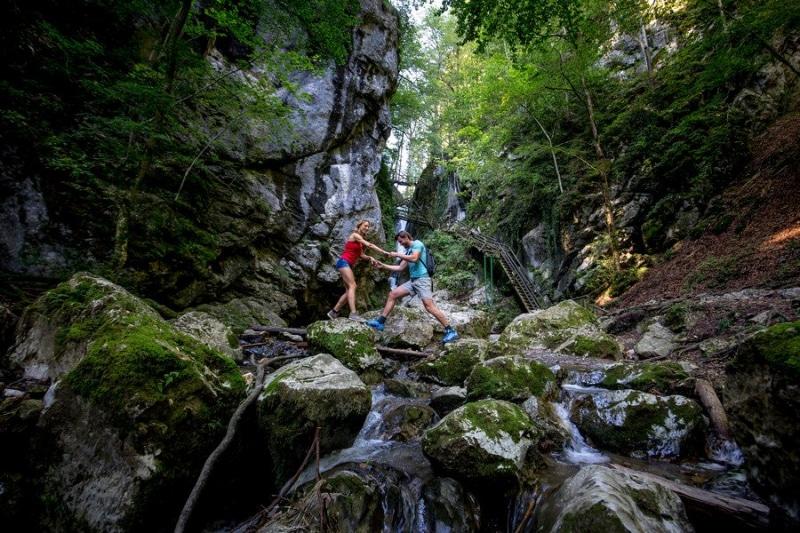
Removed from Unnamed collection
Kesselfallklamm 
The countryside immediately around Graz is wild and romantic. Among the natural attractions hidden away here are narrow gorges and gullies, through which busy streams rush. The beautiful Kesselfallklamm is like a little sister to the mighty Bärenschützklamm. Well secured steps allow you to explore this romantic gully comfortably with children too. At its northern end is the town of Semriach, a health resort popular for its air quality and treasured as a wonderful patch of Styria.
The Kesselfall gorge, the most spectacular section of the Rötschbach stream, has been accessible since 1904. The Kesselfall circle trail (R3) starts at the Sandwirt restaurant in Augraben. A pictorial sign will show you the way: a man falling into a pot (Ger. "Kessel"). Fresh from the spring, the water rushes and roars over waterfalls, in rapids and through pools. From the highest of the falls, the water plunges in cascades over a 38m drop. Thanks to more than 50 ladders and bridges, in all, about 1,800 rungs, you can experience this marvel up close. On the upper reaches of the gorge, where the Rötschbach stream is silently murmuring, the circle trail turns to the right. Walking steeply uphill, you will first reach an unusual rock formation called "Stone Gate" and will pass a cave, before going downhill and finishing the tour in the valley at Sandwirt. In one and a half hours of walking you would have covered 2.7 km and an altitude difference of 200m. https://www.graztourismus.at/en/see-and-do/sightseeing/trips-around-graz/kesselfallklamm_af-1272
Map
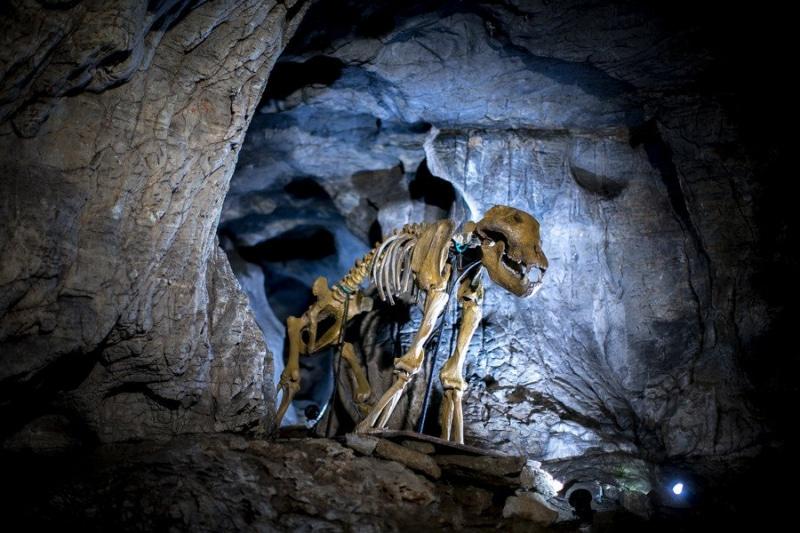
Removed from Unnamed collection
Lurgrotte Cave Peggau 
Stala‘c’tite from the ‘c’eiling, stala‘g’mite on the ‘g’round. This mnemonic can help you to identify the wonderful stone formations at the Lurgrotte, Austria’s largest dripstone cave. Here calcium mineral deposition over millions of years has yielded enchanting natural artworks both fragile and massive, with fantastic names meaning prince, giant and grand candle stick. You can explore this fascinating cavern complex accompanied by an expert guide, starting from either Peggau or Semriach.
The first person daring to enter the depths of Lurgrotte was the Italian cave scientist Max Brunello. In 1894 he discovered the Great Dome. This huge hall with an area of 120m by 80m and a height of 40m is among the biggest of its kind in central Europe and can be reached from the Semriach entrance. During guided tours a special atmosphere is created in the chamber by dramatic sound and lighting effects. Along the approximately 2km trail accessible from Semriach you can marvel, for example, at the forty-ton "giant" being probably the thickest hanging stalactite in the world. https://www.graztourismus.at/en/see-and-do/sightseeing/trips-around-graz/lurgrotte-cave-peggau_af-1213
Map

Removed from Unnamed collection
Adventure Park Graz 
Just on the outskirts of Graz there’s an exciting park, offering all manner of adventures and opportunities to explore your limits. At Abenteuer Park Graz there’s a forest climbing park, tightropes on which to balance; you can try archery, climb piles of crates and explore nature discovery trails. Here the wisdom of Confucius applies: “Tell me and I will forget. Show me and I will remember. Involve me and I will understand.” https://www.graztourismus.at/en/see-and-do/sightseeing/trips-around-graz/adventure-park-graz_af-1227
Map

Removed from Unnamed collection
Medvednica Sljeme 
Medvednica Sljeme is a rare example where a nature park is merging with a capital city. In the past, Medvednica provided protection with its castles. As well, it was the source of life because it provided residents with wood, coal, salt, stone, silver and water.
Sljeme is the highest mountain peak on Medvednica but is often used to refer to the entire mountain.
The mountain is filled with springs and streams, forests, mountain meadows and wildlife. Only a short drive from the city centre of Zagreb. For this reason, today, locals find it as an escape from city life. There are 20 archaeological sites in the Nature Park. Ranging from Prehistoric Period down to the late Middle Ages.
At the same time, there are 60+ registered cultural properties. Which testifies to the Parks abundance of cultural heritage.
With its Castles and manor houses, Medvednica was both a protector and a tyrant to locals. While the castles were made to protect, their lords used its strategic position to terrorise and pillage the locals. The legend of the Black Queen of Medvedgrad speaks of this. https://www.visitzagreb.hr/zagreb/medvednica-sljeme/
Map
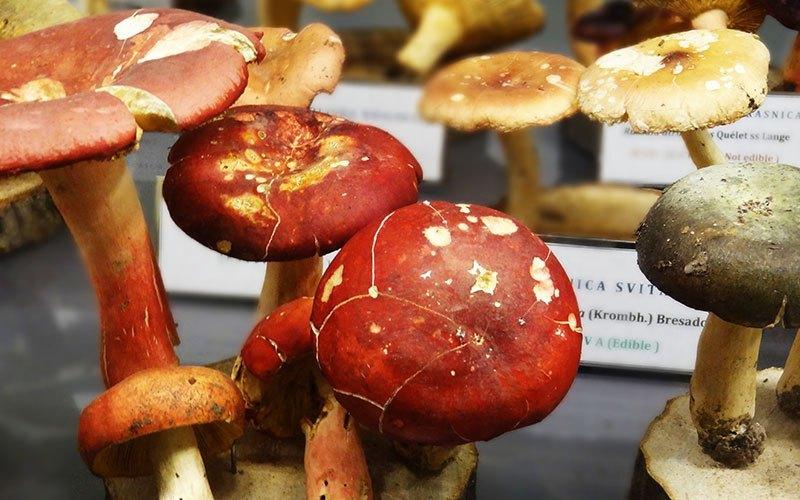
Removed from Unnamed collection
Mushroom Museum 
Mushroom Museum has up to 1250 species of real mushrooms from around the world. Including dozens of newly discovered species.
As a matter of fact, the mushrooms are freeze-dried. Which means they are alive, in their original form, size and colour. Making the Mushroom Museum unique in the world.
You have a chance to see the infamous and deadly Amanita phalloides, also known as death cap.
They are preserved in their original state so to educate visitors about mushrooms and mycology. In addition, it is about developing ecological awareness. Preserving forests from devastation and overcrowding. It is led by agronomist and greatest authority on mushrooms in Croatia, Professor Romano Bozac, D.Sc. In fact, he can take you around the exhibit, if he has the time. https://www.visitzagreb.hr/zagreb/mushroom-museum/
Map

Removed from Unnamed collection
Backo Mini Express 
Backo Mini Express is an amazing mini-train museum filled with innovation and surprises. Marvel at a very carefully constructed wonderland of trains, skiers, stations and towns. You can get up close and see how it works.
Backo Mini Express will overjoy train lovers and children with their models. After six years of work, the scale model is displayed across 75 square metres. It is constantly expanding through innovation and new models. In fact, at the moment it is the largest model in south-eastern Europe.
Although the museum is in a single room, they showcase 102 model trains across 1050 m of the railway on 8 levels. They are also featuring a miniature model of the Snow Queen Trophy at Sljeme and an ice skating rink at Tomislav Square. The ski slope is complete with snow, moving skiers, borders and cable railway.
It takes some serious engineering and technical innovations to fit all that in. As a matter of fact, they paid attention to the finest detail. Including the scenery which is extraordinary. They thought of everything, including weather control, moving road car models and people engaged in various activities. https://www.visitzagreb.hr/zagreb/backo-mini-express/
Map

Removed from Unnamed collection
Vivarium 
The Vivarium was built between 1998 and 2001 out of the Babes-Bolyai University and the Biology and Geology Faculty funds. It contains approximately 57 animal species. When it opened in 2001, it only sheltered a collection of reptiles and amphibians. Currently, alongside the reptile collection, the Vivarium also hosts 10 fish species, 9 micro mammal species and 6 bird species, out of which we can mention the Puff Adder, the Rainbow Boa, the leopard gecko, the Nile monitor, the chinchilla, the Dobrogea turtle, the salamander etc. http://www.visitclujnapoca.ro/en/atractii-turistice/muzee/page/3/the-vivarium.html
Map
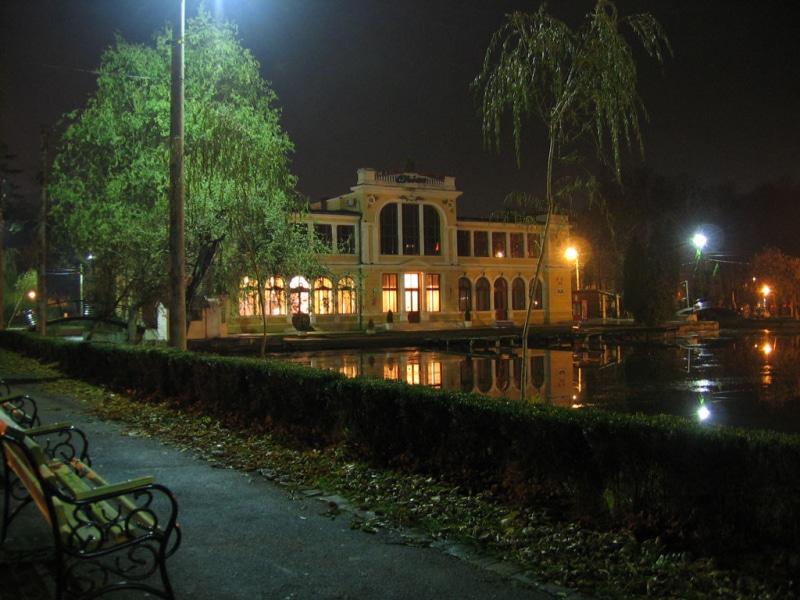
Removed from Unnamed collection
Central Park Simion Barnutiu 
Creating Central Park had been one of the first initiatives of urban remodelling of the city at the end of the 19th century. Its purpose had been the creation of a leisure spot in the close proximity of the city center. The initial name of the area field was ants’ grove situated on the bank of the river Somes. At the beginning of the 19th century, this spot was visited by all citizens of Cluj, the furrier János Meleg provided the public with refreshments.
In 1827, the Women’s Charity Organization will rent the grove with the intention to create a “place suitable for longer strolls” and a beer garden based on a contract of 12 months. This contract would also determine the municipality to initiate and sponsor some of the works necessary to drain and consolidate the land that had been a swampy area frequently flooded by the river.
In the year 1833, together with the return of the Gubernium a decision will be made on how to spend the gathered money on the development of the park. On this occasion they will establish and name the members of the Promenade comity, a council made up of important members of the urban community; they will also employ the gardener József Schütz to plant, clean and maintain the park. The park itself had been originally founded on the 22nd April 1838 and after two years the engineer Sámuel Hermann was entrusted with the design of the park. http://www.visitclujnapoca.ro/en/atractii-turistice/best-of-cluj-napoca/simion-barnutiu-central-park.html
Map
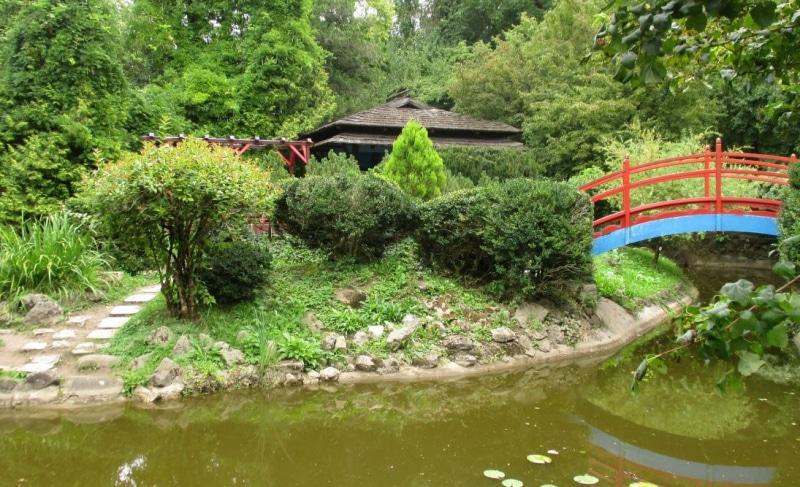
Removed from Unnamed collection
Alexandru Borza Botanical Garden 
Alexandru Borza” Botanical Garden (42 Republicii Street) – Being a national museum, the garden was founded in 1872, having an initial surface of 4.3 ha. Thanks to prof. A. Richter, the surface has reached 9.6 ha.
In 1920, professor Alexandru Borza elaborated the re-organization plan of a new botanical garden, whose arrangement was carried out from 1920 to 1930. Nowadays, the garden has a surface of 14 ha, a level difference of 20 m and is divided into various sectors, sheltering 11.000 exhibits: the ornamental sector ( The Mediterranean Garden, Rosarium, The Japanese Garden), the phytogeographic sector (the plants are arranged according to their natural associations – The Roman Garden), the systematic sector (the plants are organized by phylogenetic principles), the economic and medical sector, the sector of rare and endemic plants of Romania`s flora.
The two groups of greenhouses, having a surface of 3500 m2, with tropical plants of great scientific and utilitarian interest, are remarkable. In the precincts of the Botanical Garden functions the Botanical Institute, with its two components: the Botanical Museum (6 910 botanical pieces, representing exotic and indigenous plant exhibits) and the Herbarium (660 000 herbarium sheets of dried plants – arranged in special lockers). http://www.visitclujnapoca.ro/en/atractii-turistice/best-of-cluj-napoca/alexandru-borza-botanical-garden.html
Map
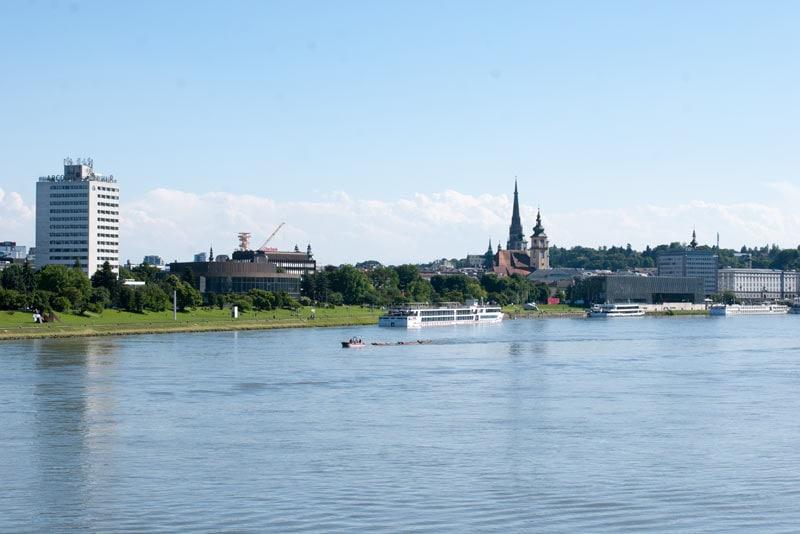
Removed from Unnamed collection
Boat ride on the Danube 
Linz changes your perspectives! Would you like to see how? Where better than by discovering the city from the Danube! You can also go on excursions into the beautiful Danube region from Linz, or take a tour or an evening cruise where you can listen to music and dine in the restaurant. The shipping companies based in Linz invite you to unwind on a boat trip on Danube, to escape the stress of everyday life and to relax on the Danube. https://www.linztourismus.at/en/leisure/discover-linz/activities/round-tours/boat-cruises/
Map
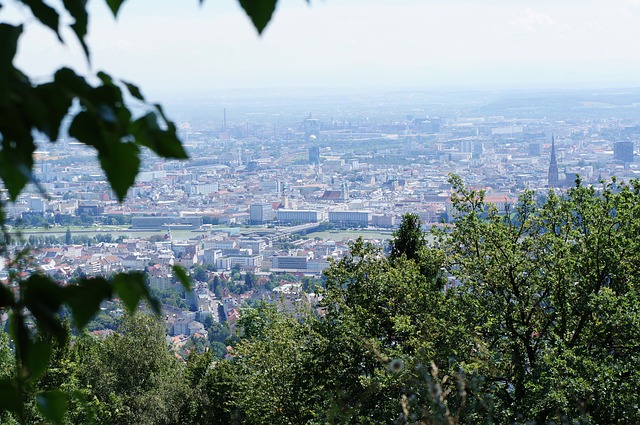
Removed from Unnamed collection
Poestlingberg 
Let's set off up Linz's local mountain! An excursion to Pöstlingberg is an unforgettable experience – not only for children! Whether families visit the pilgrimage basilica, the viewing platform, the Hartlauer Photo Gallery, the zoo or the realm of fairy tales and dwarves – the Grottenbahn, they're sure to have a great time high above Linz. Or you can enjoy the breathtaking view of the city by the colourful Danube as a cosy twosome! Change your perspectives on Linz! https://www.linztourismus.at/en/leisure/discover-linz/worth-seeing/top10/adventure-world-poestlingberg/
Map
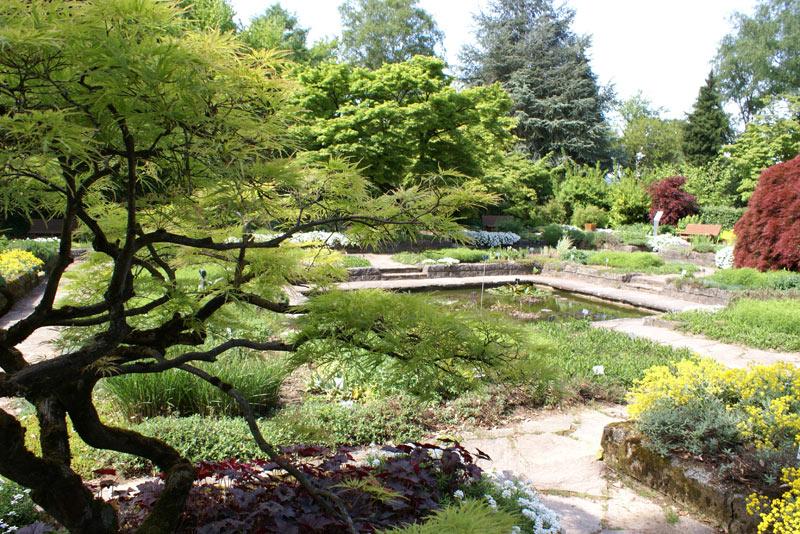
Removed from Unnamed collection
Botanical Garden Linz 
The Botanical Garden on the "Gugl" are among the most beautiful in Europe. Over an area of 43,000 m², there are more than 10,000 various types of plants to admire. In the five greenhouses the splendour of exotic specimens predominates the garden’s unique collection of cacti, the finest in Europe.
The natural conditions allow the exhibited plants to be grouped in complete landscapes, so that visitors can imagine they are in the middle of the plant’s natural habitat. https://www.linz.at/english/tourism/921.asp
Map






